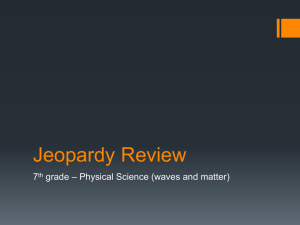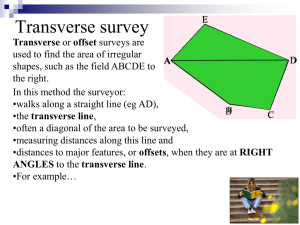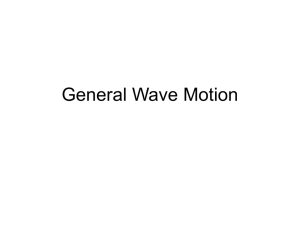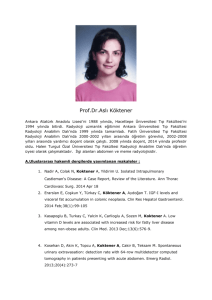Notes 4 - Waveguides part 1 general theory
advertisement
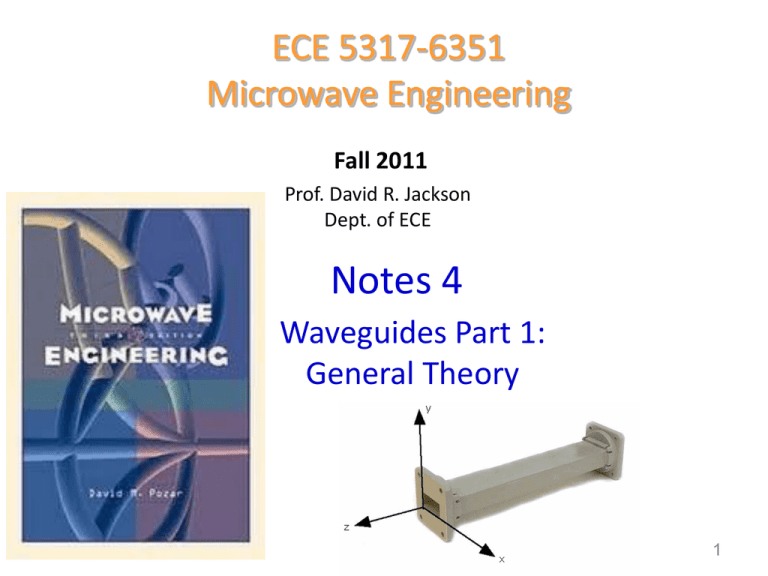
ECE 5317-6351 Microwave Engineering Fall 2011 Prof. David R. Jackson Dept. of ECE Notes 4 Waveguides Part 1: General Theory 1 Waveguide Introduction In general terms, a waveguide is a devise that confines electromagnetic energy and channels it from one point to another. Examples – Coax – Twin lead (twisted pair) – Printed circuit lines (e.g. microstrip) – Optical fiber – Parallel plate waveguide – Rectangular waveguide – Circular waveguide Note: In microwave engineering, the term “waveguide” is often used to mean rectangular or circular waveguide (i.e., a hollow pipe of metal). 2 General Solutions for TEM, TE and TM Waves Assume ejt time dependence and homogeneous source-free materials. Assume wave propagation in the z direction e jk z , z e y PEC jk z z k z j x E x , y , z e t x , y zˆ e z x , y e jk z z J E transverse components H x , y , z h t x , y zˆ h z x , y e , , z jk z z 3 Helmholtz Equation E j H H j E J E v H 0 E j H j j E J Vector Laplacian definition : E E E 2 where 2 2 2 2 E xˆ E x yˆ E y zˆ E z 4 Helmholtz Equation E j H j j E J E E j j E J 2 v 2 2 E E j J v E E j J 2 2 v E E j E 2 2 Assume Ohm’s law holds: J E 5 Helmholtz Equation (cont.) v E E j E 2 2 2 2 E j E v 2 2 E c E v k c 2 2 2 2 E k E v Next, we examine the term on the right-hand side. 6 Helmholtz Equation (cont.) To do this, start with Ampere’s law: v E k E 2 H j E J H j E J 2 H j E E 0 E j E 0 v 0 In the time-harmonic (sinusoidal steady state, there can never be any volume charge density inside of a linear, homogeneous, isotropic, source-free region that obeys Ohm’s law. 7 Helmholtz Equation (cont.) Hence, we have Ek E 0 2 2 Helmholtz equation 8 Helmholtz Equation (cont.) Similarly, for the magnetic field, we have H j E J H j E J H j E E H j E H j c E H j c j H H H 2 j c j H 9 Helmholtz Equation (cont.) Hence, we have H k H 0 2 2 Helmholtz equation 10 Helmholtz Equation (cont.) Summary Ek E 0 2 2 H k H 0 2 2 Helmholtz equations These equations are valid for a source-free homogeneous isotropic linear material. 11 Field Representation Assume a guided wave with a field variation in the z direction of the form jk z e z Then all six of the field components can be expressed in terms of these two fundamental ones: Ez, H z 12 Field Representation (cont.) Types of guided waves: TEMz TEMz: Ez = 0, Hz = 0 TMz: Ez 0, Hz = 0 TEz: Ez = 0, Hz 0 Hybrid: Ez 0, Hz 0 TMz , TEz Hybrid w r h Microstrip 13 Field Representation: Proof Assume a source-free region with a variation e H j c E E j H 1) 2) 3) E z y jk z E y j H x jk z E x E y x E z E x y x j H y j H z jk z z 4) 5) 6) H z y jk z H y j c E x jk z H x H y x H z H x y x j c E y j E z 14 Field Representation: Proof (cont.) Combining 1) and 5) 1 H z jk z jk z H x j H x y x j c E z E z y 2 kz j Hx x j c k z H z c j c E z y jk z H x z (k k z ) H x 2 2 2 kc Hx E z j c 2 kc y kz x H kc k k 2 2 z 1/ 2 z Cutoff wave number A similar derivation holds for the other three transverse field components. 15 Field Representation (cont.) Summary Hx E z j c 2 kc y kz H z x E z H z j H y 2 c kz kc x y Ex Ez H z j k z 2 kc x y These equations give the transverse field components in terms of longitudinal components, Ez and Hz. k c 2 2 kc k k 2 j Ey 2 kc kz H z y x Ez 2 z 1/ 2 16 Field Representation (cont.) Therefore, we only need to solve the Helmholtz equations for the longitudinal field components (Ez and Hz). Ez k Ez 0 2 2 Hz k Hz 0 2 2 17 Transverse Electric (TEz) Waves Ez 0 The electric field is “transverse” (perpendicular) to z. In general, Ex, Ey, Hx, Hy, Hz 0 To find the TEz field solutions (away from any sources), solve ( k ) H z 0 2 2 2 2 2 2 ( k ) H z 0 2 k Hz 0 2 2 y z x 2 2 18 Transverse Electric (TEz) Waves (cont.) 2 2 2 2 k 2 Hz 0 2 2 y z x Recall that the field solutions we seek are assumed to jk z z vary as jk e 2 2 2 2 2 kz k 2 x y k c2 H z ( x , y , z ) hz ( x , y ) e hz x , y 0 2 2 2 2 k h x, y 0 c z 2 y x 2 2 2 2 h x , y k hz x , y z c 2 y x z z kc k k z 2 2 2 Solve subject to the appropriate boundary conditions. (This is an eigenvalue problem.) 2 T h e e ig e n v a lu e k c is a lw a ys re a l. 19 Transverse Electric (TEz) Waves (cont.) Once the solution for Hz is obtained, jk z H z Hx H y 2 kc x jk z H z 2 kc y Ex Ey j H z 2 kc y j H z 2 kc x For a wave propagating in the positive z direction (top sign): Ex Hy Ey Hx kz For a wave propagating in the negative z direction (bottom sign): Ex Hy Ey Hx TE wave impedance kz Z TE kz 20 Transverse Electric (TEz) Waves (cont.) Also, for a wave propagating in the positive z direction, ˆ y x, y e t x , y xˆ e x x , y ye ˆ x xe ˆ y zˆ e t ye e x Z TE h y ˆ x yh ˆ y zˆ e t Z T E xh e y Z TE hx Z TE h t ht 1 Z TE ( zˆ e t ) Similarly, for a wave propagating in the negative z direction, ht 1 Z TE ( zˆ e t ) ht x, y 1 Z TE zˆ e x , y t 21 Transverse Magnetic (TMz) Waves Hz 0 In general, Ex, Ey, Ez ,Hx, Hy 0 To find the TEz field solutions (away from any sources), solve ( k ) E z 0 2 2 2 2 2 2 2 2 ( k ) E z 0 2 k Ez 0 2 2 y z x 22 Transverse Magnetic (TMz) Waves (cont.) 2 2 2 2 2 k k z 2 x y 2 k c ez x, y 0 2 2 2 2 kc ez x, y 0 2 y x kc k k z 2 2 2 solve subject to the appropriate boundary conditions 2 2 2 2 e x , y k e x, y c z 2 z y x (Eigenvalue problem) 23 Transverse Magnetic (TMz) Waves (cont.) Once the solution for Ez is obtained, Hx j c E z Ex y 2 kc j c E z Hy x 2 kc Ey jk z E z 2 kc x jk z E z 2 kc y For a wave propagating in the positive z direction (top sign): Ex Hy Ey Hx kz c For a wave propagating in the negative z direction (bottom sign): Ex Hy Ey Hx kz c TM wave impedance Z TM kz c 24 Transverse Magnetic (TMz) Waves (cont.) Also, for a wave propagating in the positive z direction, ˆ y x, y e t x , y xˆ e x x , y ye ˆ x xe ˆ y zˆ e t ye zˆ e t Z T M ˆ xh e x Z TM h y x ˆ y yh e y Z TM hx Z TM h t ht 1 Z TM ( zˆ e t ) Similarly, for a wave propagating in the negative z direction, ht 1 Z TM ( zˆ e t ) ht x, y 1 Z TM zˆ e x , y t 25 Transverse ElectroMagnetic (TEM) Waves Ez 0 , H z 0 In general, Ex, Ey, Hx, Hy 0 From the previous equations for the transverse field components, all of them are equal to zero if Ez and Hz are both zero. Unless kc 0 2 (see slide 16) 2 2 2 For TEM waves k c k k z 0 Hence, we have kz k c 26 Transverse ElectroMagnetic (TEM) Waves (cont.) In a linear, isotropic, homogeneous source-free region, E 0 In rectangular coordinates, we have E x x E y y E z z 0 Notation: t xˆ t E 0 t et x , y e e t x yˆ y 0 e x, y 0 e x, y 0 jk z z jk z z t t t t et x , y 0 27 Transverse ElectroMagnetic (TEM) Waves (cont.) Also, for the TEMz mode we have from Faraday’s law (taking the z component): zˆ E zˆ j H j H z 0 Taking the z component of the curl, we have E y x E x y Notation: 0 Hence e y x ex y t xˆ 0 x yˆ y or t et x , y 0 t et x , y 0 28 Transverse ElectroMagnetic (TEM) Waves (cont.) t et x , y 0 et x , y t x , y t et x , y 0 t t x, y 0 Hence t x, y 0 2 29 Transverse ElectroMagnetic (TEM) Waves (cont.) Since the potential function that describes the electric field in the cross-sectional plane is two dimensional, we can drop the “t” subscript if we wish: x, y 0 2 x, y 0 2 Boundary Conditions: x , y V a co n d u cto r " a " a b x , y V b co n d u cto r " b " This is enough to make the potential function unique. Hence, the potential function is the same for DC as it is for a highfrequency microwave signal. 30 Transverse ElectroMagnetic (TEM) Waves (cont.) Notes: A TEMz mode has an electric field that has exactly the same shape as a static (DC) field. (A similar proof holds for the magnetic field.) This implies that the C and L for the TEMz mode on a transmission line are independent of frequency. This also implies that the voltage drop between the two conductors of a transmission line carrying a TEMz mode is path independent. A TEMz mode requires two or more conductors (a static field cannot be supported by a single conductor such as a hollow metal pipe. 31 TEM Solution Process A) Solve Laplace’s equation subject to appropriate B.C.s.: 2 x , y 0 B) Find the transverse electric field: C) Find the total electric field: D) Find the magnetic field: E x, y , z et x , y e H 1 Z TE M Z TEM kz k et x , y x , y zˆ E ; jk z z , kz k z p ro p a g a tin g 32




